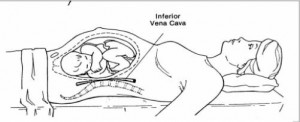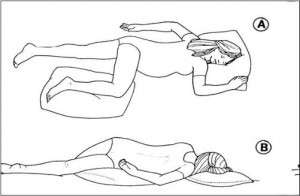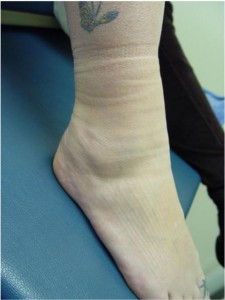a. Supine Hypotension (Vena Cava Syndrome) (See figure 5-2).
(1) Supine hypotension is caused by pressure of the gravid uterus on the ascending vena cava when the woman is supine which decreases the return of the blood.
(2) Symptoms include nausea, cold and clammy, feels faint, and hypotensive (decreased blood pressure).
(3) Nursing interventions consist of advising the patient to:
(a) Get up slowly.
(b) Use the side-lying position, preferably on the left side.

b. Varicose Veins.
(1) Varicosity is an enlargement of the lumen of a vein due to thinning and stretching of its walls.
(2) It is caused by the relaxation of smooth muscle walls of veins, which is due to increased hormones (progesterone), which causes pelvic vasocongestion. This condition is aggravated during pregnancy due to the enlarging uterus in the pelvis causing pressure on the great abdominal veins, which interferes with return blood flow from the lower extremities. It is also aggravated by gravity and bearing down for bowel movements. This may also be a hereditary disposition.
(3) Varicosity involves the veins of the lower extremeties (legs), the external genitalia (vulva or labia), the pelvis, and the perineal area (hemorrhoids).
(4) Nursing intervention consists of advising the patient to:
(a) Avoid obesity.
(b) Avoid lengthy standing or sitting.
(c) Avoid constrictive clothing.
(d) Avoid constipation and bearing down.
(e) Elevate legs when sitting.
(f) Get adequate rest.
(g) Perform moderate exercise.
(5) Treatment once varicose veins have developed.
(a) Rest with legs and hips elevated.
(b) Wear support stockings before rising (getting up) if varicose veins are severe.
(c) Lie on the bed with legs extended at a right angel to the body if ordered by the physician (see figure 8-3 A).
(d) If in the vulva, may be relieved by placing a pillow under the buttocks to elevate the hips, assuming the Sim’s position (see figure 8-3 B) for a few minutes several times a day, avoid standing as much as possible, or laying down instead of sitting when practical.
(e) To relieve pain and swelling, take hot sitz baths or local application of astringent compresses (witch hazel pads).

c. Edema (Ankle Edema, Nonpitting to Lower Extremities).

(1) Edema is very common during pregnancy. It most often occurs during the second and third trimesters. Edema is caused by reduced blood circulation in the lower extremities as the gravid uterus puts pressure on the large vessels. Edema is most noticeable at the end of the day and it is normal in pregnancy as long as it is not accompanied by the following:
(a) Proteinuria (the presence of an excess of serum proteins in the urine).
(b) Edema of nondependent parts.
(c) Sudden increase in weight.
(d) Hypertension.
(2) Nursing intervention consists of advising the patient to:
(a) Maintain good posture.
(b) Avoid prolonged standing or sitting.
(c) Wear support stockings.
(d) Avoid constrictive clothing (garters, knee-high hose).
(e) Drink at least eight glasses of fluid for “natural” diuretic effect.
(f) Get adequate rest and exercise; include rest periods to elevate legs.
(3) Treatment of ankle edema.
(a) Elevate the feet as often as possible.
(b) Apply support stockings before getting up.
(c) Diuretics are contraindicated.
(4) If condition worsens to a generalized edema, the patient should notify her physician.
